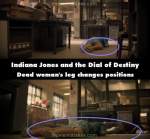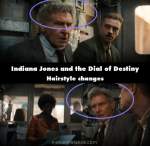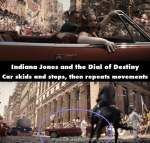Other mistake: In Tangiers, Indy's cab pulls over in front of the mob-owned hotel where the famous illegal auction is taking place. It's dark outside, but when we see Indy in the hotel, and more evidently when they get out of the hotel and the car chase starts in the span of 5 minutes, it's broad daylight. That also means that just before 6 AM (when dawn would take place in August), the hotel is chock full of normal people boozing, playing cards, plus an assembly of rich baddies from all over the world who just happen to wait to have an auction.
Continuity mistake: When Teddy is abducted, Indy runs towards the car, past a hat lying on the street. The shot changes, and he is metres behind, running towards the hat again.
Continuity mistake: After Indy melts the wax and reads the dial, he is holding it with his right hand in one shot and with both hands in the immediate angle.

Continuity mistake: When Indy and Helena find the antikythera in Archimedes' tomb, it's covered in dust and no features are visible. When Indy reaches for it, it's just slightly dusty.
Continuity mistake: Indy rides on horseback through a banner held by a women and rips it apart. The shot changes, and the women and the broken banner have all disappeared.
Audio problem: After Wombat greets Indy at the bar, from a side shot her jaw is moving, but no sound is heard.
Continuity mistake: Indy closes the cap of the whisky bottle and watches the separation agreement. The shot changes to a close-up, and he is closing the cap again.

Continuity mistake: A woman is shot at at the college and lies down with her right leg bent. A man tries to move her but is killed before he does. The shot changes and her right leg has swapped to lying straight.
Continuity mistake: During the chase in Tangiers, after the stolen watch discussion, Indy's tuk tuk stops next to a street where a man approaches. The shot changes and the street is replaced with a wall and the man is gone.

Continuity mistake: When Indy is abducted during parade day inside the truck, his hairstyle keeps changing all the time.
Other mistake: The US forces that apprehend Voller in Tanger carry modern-day M4 carbines. These weren't in use until the early 1990s. While similar weapons (XM177) were in limited use in the late 60s, the troops sent to apprehend Voller would much more likely have had regular M16s or WW2 M1 carbines.
Factual error: The cutscene when Indy travels to Morocco shows a clip of a train traveling at high speed through the desert. These are actually Belgian-manufactured trains and didn't operate in Morocco until around 1990, while the film's plot takes place in 1969.
Factual error: The plunder train is revealed to have travelled through the French Alps, when it was captured by the British. However, this would've meant the train was travelling through areas that still would've been under the Vichy regime. Most of these areas, while they did face Allied bombing, were liberated by French troops, not British. (The British and Americans were more concerned with heading for Germany).

Revealing mistake: During the tuk tuk chase, skid marks from previous takes are visible on the road. (01:03:13)

Revealing mistake: When the AA machinegun on the train goes berserk and destroys everything, Indy hides behind some crates. For several shots, Harrison Ford is replaced by a lame CGI, which transforms his head into a videogamish, lifeless face.

Revealing mistake: When young Indy jumps from his car to the motorbike and fights against a German - and the following scene where he rides on the bike towards the train - his body and especially his face are a blatant CGI creation with unnatural movements, dead eyes, and waxy, lifeless expressions (most noticeable in theater screenings). (00:05:53)

Continuity mistake: During the parade, a red convertible skids and stops in front of Indy. Shot changes and it's skidding and stopping again.
Revealing mistake: During the flashback scene, when young Indy jumps on top of the train and runs on the roof of the carriages, it's a very obvious and lame animation with unrealistic movements.
Factual error: Colonel Weber is not an Oberst, but an SS-Oberführer. Given all his men are also SS, there is no likelihood they would use an army rank to address him, especially one that is junior to his actual rank.
Suggested correction: In fact, Oberst is the literal translation of the word "Colonel" into German. It would not be unusual for Germans to call a colonel by his rank in his native language (even if he is an SS colonel).
There is no chance that SS men would use an army rank when referring to an SS officer. That would be like a sailor calling a naval captain "colonel" because the ranks are equivalent.





